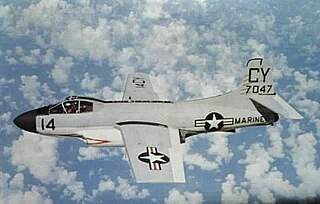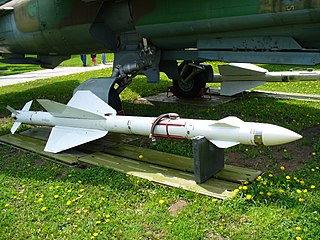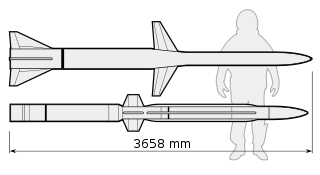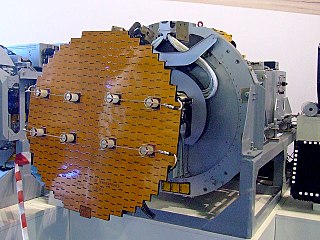Related Research Articles

The AIM-120 Advanced Medium-Range Air-to-Air Missile(AMRAAM) ( AM-ram) is an American beyond-visual-range air-to-air missile capable of all-weather day-and-night operations. It uses active transmit-receive radar guidance instead of semi-active receive-only radar guidance. When an AMRAAM missile is launched, NATO pilots use the brevity code "Fox Three".

The AIM-54 Phoenix is an American active radar-guided, beyond-visual-range air-to-air missile (AAM), carried in clusters of up to six missiles on the Grumman F-14 Tomcat, its only operational launch platform.

The Douglas F3D Skyknight is an American twin-engined, mid-wing jet fighter aircraft designed and manufactured by the Douglas Aircraft Company.

The British Aerospace Sea Harrier is a naval short take-off and vertical landing/vertical take-off and landing jet fighter, reconnaissance and attack aircraft. It is the second member of the Harrier family developed. It first entered service with the Royal Navy in April 1980 as the Sea Harrier FRS1 and became informally known as the "Shar". Unusual in an era in which most naval and land-based air superiority fighters were large and supersonic, the principal role of the subsonic Sea Harrier was to provide air defence for Royal Navy task groups centred around the aircraft carriers.

The North American XF-108 Rapier was a proposed long-range, high-speed interceptor aircraft designed by North American Aviation intended to defend the United States from supersonic Soviet strategic bombers. The aircraft would have cruised at speeds around Mach 3 with an unrefueled combat radius over 1,000 nautical miles, and was equipped with radar and missiles offering engagement ranges up to 100 miles (160 km) against bomber-sized targets.

The Douglas F6D Missileer was a proposed carrier-based fleet defense fighter designed by Douglas Aircraft Company in response to a 1959 United States Navy requirement. It was designed to be able to loiter for extended periods at a relatively long distance from the Navy's aircraft carriers, engaging hostile aircraft 100 miles (160 km) away with its powerful radar and long-range missiles. Since the enemy would be fired on long before they reached visual range, the aircraft had little dogfighting capability and was strictly subsonic. When doubts were expressed about the Missileer's ability to defend itself after firing its missiles, the value of the project was questioned, leading to its cancellation. Some of the Missileer's systems, primarily the engines, radar, and missiles, continued development in spite of the cancellation, eventually emerging on the ill-fated General Dynamics–Grumman F-111B and successful Grumman F-14 Tomcat years later.

The Vympel R-23 is a medium-range air-to-air missile developed by Vympel in the Soviet Union for fighter aircraft. An updated version with greater range, the R-24, replaced it in service. It is comparable to the American AIM-7 Sparrow, both in terms of overall performance as well as role.

The AIM-152 Advanced Air-to-Air Missile (AAAM) was a long-range air-to-air missile developed by the United States. The AIM-152 was intended to serve as the successor to the AIM-54 Phoenix. The program went through a protracted development stage but was never adopted by the United States Navy, due to the ending of the Cold War and the reduction in threat of its perceived primary target, Soviet supersonic bombers. Development was cancelled in 1992.

The AN/APG-66 radar is an X-band solid state medium range pulse-Doppler planar array radar originally designed by the Westinghouse Electric Corporation for use in early generations of the F-16 Fighting Falcon. Later F-16 variants use the AN/APG-68 or the AN/APG-83. This radar was employed in all domestic and export versions of the F-16A/B models throughout the production. Subsequent upgrades have been installed in many varying aircraft types including the U.S. Customs and Border Protection's C-550 Cessna Citation, US Navy P-3 Orion, and Piper PA-42 Cheyenne II's.

The Sukhoi Su-30MKM is a twin-engine supermaneuverable fighter of the Royal Malaysian Air Force (RMAF). It is a variant of the Su-30 series fighters, with many significant improvements over the original Su-30MK export version. The Su-30MKM was developed by the Sukhoi Design Bureau and is based on the Su-30MKI of the Indian Air Force. Both aircraft have common airframe, thrust vectoring engines and a digital fly-by-wire system, however the MKM version differs from the MKI mainly in the composition of the onboard avionics. It can carry up to 8,000 kg (17,637 lb) payload over a 1,296 km un-refueled combat radius.

The Sukhoi Su-30MKK is a modification of the Sukhoi Su-30, incorporating advanced technology from the Sukhoi Su-35 variant. The Su-30MKK was developed by Sukhoi in 1997, as a result of a direct Request for tender between the Russian Federation and China. It is a heavy class, all-weather, long-range strike fighter, and like the Sukhoi Su-30, comparable to the American McDonnell Douglas F-15E Strike Eagle. The Sukhoi Su-30MK2 is a further improvement to Su-30MKK with upgraded avionics and maritime strike capabilities. The MKK and MK2 are currently operated by the People's Liberation Army Air Force, Indonesian Air Force, Vietnam People's Air Force, Venezuelan Air Force and the Ugandan Air Force.

The KJ-2000 is a Chinese second-generation airborne early warning and control (AEW&C) aircraft developed by the Shaanxi Aircraft Corporation, and is the first AEW&C system in service to the People's Liberation Army Air Force. It is built upon a modified Russian Ilyushin Il-76 airframe using domestically designed avionics and a fixed radome featuring three active electronically scanned array (AESA) radars each covering a 120-degree sector, unlike the rotating radome on the comparable E-3 Sentry serving the United States Air Force.
The Mitsubishi AAM-4 is a medium-range active radar homing air-to-air missile. It is a modern beyond-visual-range missile developed in Japan and intended to replace the semi-active radar homing AIM-7 Sparrow missile in service. It has been operational since 1999. The main contractor is Mitsubishi Electric. The 2010 AAM-4B was the world's first air-to-air missile with an AESA radar seeker.

The Zhuk are a family of Russian all-weather multimode airborne radars developed by NIIR Phazotron for multi-role combat aircraft such as the MiG-29 and the Su-27. The PESA versions were also known as the Sokol.

The IAI Nammer was a fighter aircraft developed in the Israeli aerospace manufacturing Israel Aerospace Industries (IAI) during the late 1980s and early 1990s. The programme was pursued as a private venture and the resultant aircraft was intended for the export market.

The General Dynamics–Grumman F-111B was a long-range carrier-based interceptor aircraft planned as a follow-on to the McDonnell Douglas F-4 Phantom II for the United States Navy (USN).

The AN/APQ-120 was an aircraft fire control radar (FCR) manufactured by Westinghouse for the McDonnell Douglas F-4E Phantom II. AN/APQ-120 has a long line of lineage, with its origin traced all the way back to Aero-13 FCR developed by the same company in the early 1950s. A total of half a dozen FCRs were tested and evaluated on the first 18 F-4s built, but they were soon replaced by later radars produced in great numbers, including AN/APQ-120.

The British Aerospace Hawk 200 is a single-seat, single engine light multirole fighter designed for air defence, air denial, anti-shipping, interdiction, close air support, and ground attack.
The Grifo radar is a family of airborne radars developed by Italian firm Leonardo S.p.A. for fighter aircraft and attack aircraft, and this family of radars includes several series.
References
- 1 2 3 "Ancile". www.deagel.com.
- ↑ "LCA Set to Fly with Israeli Radar | AVIATION WEEK". Archived from the original on 2011-05-10. Retrieved 2022-03-06.
- 1 2 3 "ELM-2032".